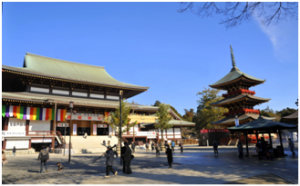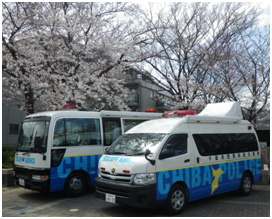So where is Chiba Prefecture?
Chiba Prefecture is one of Japan’s 47 prefectures. Bordering the east of Tokyo Metropolis and enjoying all the advantages of being near the Tokyo metropolitan area, it is an area with a mild climate and with fertile soil, surrounded by the bountiful sea providing a rich variety of seafood, meaning Chiba is a prefecture graced with lush countryside and a wealth of natural resources.
Narita International Airport is in the Prefecture and sees around half of the total 20 million tourist visitors from overseas visiting Japan every year. Tokyo Disney Resort is also in the prefecture, Asia’s most popular theme park.
However, the many visitors from overseas arriving at Narita International Airport transfer to other areas of Japan, primarily to Tokyo, rather than staying in Chiba. As this is the case, Chiba is not very well known by people overseas.
Nature and culture in Chiba
Throughout the area from the east to the south of Chiba Prefecture, the atmosphere differs from the northwest area which is close to Tokyo. The attractions include a tranquil typical Japanese countryside and a variegated coast, all kinds of fresh sea food, a variety of flowers, all changing with the seasons.
Additionally, shrines and temples are popular spots to experience traditional Japanese culture, and in Chiba Prefecture sites such as Naritasan Shinsho-ji Temple, Katori Jingu Shrine and others are all examples of Japan’s historical architectural heritage of temples. Naritasan Shinsho-ji Temple is the second most visited in Japan (particularly popular for New Year prayers) seeing about 3 million people on the three days of the New Year Holiday. The history of Katori Jingu Shrine is said to stretch back to a temple built 2,600 years ago and is a popular location believed to possess a mystical energy. Also there, at the Nihon-ji Temple which was built around 1,300 years ago on the same site, there is a very impressive giant statue of the Buddha carved from the rock hillside.
Tokyo Olympic and Paralympic Games and Chiba Prefecture
As has been well reported, Tokyo will host the 2020 Olympic and Paralympics Games, and seven events will take place in Chiba Prefecture. These will be the Olympic fencing, wrestling, Taekwondo events and Paralympic wheelchair fencing, Taekwondo, goalball, and sitting volleyball. The Makuhari Messe Conference and Exhibition Centre will be the venue for the events.
Makuhari Messe, of which Chiba Prefecture, Chiba City the Development Bank of Japan are the largest shareholders, was opened on October in 1989 and is one of the biggest meeting and exhibition facilities in Japan. It is used for industry trade shows, music and sports events. Makuhari Messe is at the heart of ‘Makuhari Shintoshin’ development (literally new urban centre) where near to 500 companies have gathered, with restaurants, shops and leisure facilities as well as hotels located together.
It’s also where the crowds gather for the so called F1 of the skies, the Redbull Air Race World Championships held there. At the first 2015 event held in Makuhari Shintoshin around 120,000 people came to see the heats of the two days. This big event was also held in the UK in 2005 as many people will know.
In Chiba Prefecture, the Olympics and Paralympics will see developments triggered by the economic opportunity presented. Preparations will be made for training camp invitations for the athletes as well as for the arrival of visitors from overseas, with improvements to access for Narita International Airport as well as other areas in the prefecture, and planning the increased appeal of the area through the creation of visitor tour routes.
Safe and secure urban management is also another important measure. While Japan is a country widely regarded as being safe where people are generally able to go out at night feeling secure, as well as get on trains or walk home without having to worry about dangerous areas, this does not mean that there is no crime in Japan at all. Apart from having ‘police stations’ in Japan, police buildings also include police ‘koban’ (or police boxes), numerous small street facing neighbourhood substations. In Chiba Prefecture, in addition to ‘koban’, movable ‘koban wagons’ have been used since 2010 as well as an increase in patrols. The prefectural government is also aiming to improve measures with the police and municipalities in the area as well as with citizens to improve security such as security cameras and mobile manned police boxes.
Photo / image: copyright Chiba Prefecture
Sign up on our website homepage to receive our eNews updates





